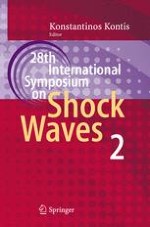2012 | OriginalPaper | Buchkapitel
Experimental Investigation of Shock Train Induced Turbulence
verfasst von : A. Grzona, H. Olivier
Erschienen in: 28th International Symposium on Shock Waves
Verlag: Springer Berlin Heidelberg
Aktivieren Sie unsere intelligente Suche, um passende Fachinhalte oder Patente zu finden.
Wählen Sie Textabschnitte aus um mit Künstlicher Intelligenz passenden Patente zu finden. powered by
Markieren Sie Textabschnitte, um KI-gestützt weitere passende Inhalte zu finden. powered by
Inside a nozzle with small opening angle the re-compression from supersonic to subsonic flow conditions is conducted by a shock train when the back pressure and the relative thickness of the boundary layer compared to the nozzle height are sufficiently high. A sketch of a typical shock train is depicted in Fig. 1a. Due to the boundary layer effect a series of shocks alternating with expansion zones is formed and the re-compression spans over a certain distance. The shock region is followed by a turbulent mixing region, where the subsonic turbulence layers originating at the foot of the first shock grow together. The turbulent fluctuations homogenise the flow and are accompanied by a rise in static pressure (see Fig. 1d). Caused by shear layers and the associated mixing process, the overall pressure rise in a shock train is lower than for a single normal shock with the same pre-shock conditions. A detailed description of the shock train phenomenon and a comprehensive review of its timeaveraged behaviour can be found in [1]. The normal Reynolds stress throughout the shock train on the centre line was measured by [2]. For the cases of a lambda-foot shock train and a x-type shock train a strong intensification of the turbulent fluctuations was observed in the mixing region. The magnitude of the maximum normal Reynolds stress on the centre line strongly depends on the pre-shockMach number. In the present investigation movable hot-wire probes are used to measure the distribution of the turbulent fluctuations over the complete nozzle height at different positions inside the shock train and the following mixing region. This allows to capture the growth of the turbulence layer. Figure 1b shows a Schlieren image of the flow with the hot-wire probe positioned on the centre line at the beginning of the turbulent mixing layer. Schlieren images with a shorter illumination time show the turbulent structures emerging from the shock/boundary layer interaction (Fig. 1c).
